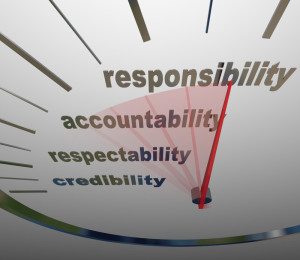“The problem that we have with a victim mentality is that we forget to see the blessings of the day. Because of this, our spirit is poisoned instead of nourished.” – Steve Maraboli
As a leader there are few things more important than creating a strong and healthy organizational culture for your employees to thrive in. It’s up to you as the leader to be proactive and take the lead in developing the organizational climate you wish to have.
Unfortunately, many harmful behaviors threaten the fabric of the culture that you are trying to create. These behaviors include bullying, manipulation, office politics, etc., and they each pose a real threat. But there is one in particular that we would like to address – so here is our question: Is a victim mentality preventing accountability in your organization?
No doubt there are accountability measures in place within your organization that serve to track performance and measure each person’s progress. Accountability measures are healthy and necessary and keep everyone focused on shared goals and outcomes.
But what happens when a team member perpetuates a victim mentality? What does it sounds like? Here are five common claims that will give you some insight.
It’s not fair
The “it’s not fair” mantra is perhaps the oldest one in the book. It can be used when an employee feels that his or her work has gone unnoticed, was passed over for a raise or promotion, or has made an improper comparison of the value of their work in relation to a colleague. Whether justified or not, this feeling of being on the receiving end of unfair treatment is a source of concern. As a leader it is up to you to address it. Accountability makes sense when each person on the team has a clear picture of the value they bring to the organization. Don’t let an employee’s feelings of being slighted go unanswered. When they see and understand their importance they will not see accountability as a threat.
Finger pointing
Finger pointing is so destructive because it’s so easy. It’s the first gesture of the least accountable. Yet sadly, the blame game is alive and well. But clear expectations of employee performance along with useful accountability guidelines will go a long way toward bringing an end to finger pointing and fault-finding. As a leader, you must take ownership of these expectations. When employees can build a collaborative team environment around the idea that “we are in this together”, it can unleash everything that is good and creative about your people. Finger pointing now gives way to mutual accountability, and fault-finding takes a back seat to an “I’ve got your back” mentality. Which would you rather have?
It’s Not My Job
When employees have the mindset that they are only responsible for specific, outlined tasks, it is easy for them to dodge accountability with the simple statement, ‘it’s not my job’. The most effective organizations are the ones where everyone has the opportunity to make an impact. As a leader, you must create a culture of collaboration and teamwork where everyone feels they have a vested interest in the outcome. Let employees see you roll up your sleeves and do what needs to be done regardless of your formal job description. Achieve accountability by replacing the mindset of ‘it’s not my job’ with ‘I benefit when everyone participates as a whole’.
Feeling Powerless
Employees will not take accountability for decisions or tasks which they feel they have no control over. As a leader, you must provide employees with pertinent information and encourage them to ask questions. Then, give them the power to make decisions and design how their work gets done. Accountability will increase dramatically when employees are given power and control over their own work.
Denying Responsibility
Employees often deny responsibility out of fear or frustration. They fear the repercussions for failure or they are frustrated by a lack of clear expectations and control over their work. As a leader, you must create a team mentality. Help employees understand that when one team member fails to carry their weight, they drag down the performance of the whole team. Inspire in them shared values and clearly communicate expectations. Teach problem solving and creative conflict resolution skills throughout your organization. Increase accountability by removing the fear of failure and building employee confidence by giving them a sense of control.
As a leader, it is your responsibility to develop a culture that encourages accountability and discourages a victim mentality. If your employees willingly accept accountability for their decisions and actions, your organizational effectiveness will skyrocket.
© 2015 Doug Dickerson & Elizabeth Stincelli
Doug Dickerson is an internationally recognized leadership author, columnist, radio host, and speaker. He is the author of two books, Leaders Without Borders, 9 Essentials for Everyday Leaders, and Great Leaders Wanted! Follow him at www.twitter.com/managemntmoment. He lives just outside beautiful Charleston, SC. To invite Doug to speak email him at managementmoment@gmail.com
Elizabeth Stincelli is passionate about recognizing and inspiring the leader in each of us. She is the CEO of Stincelli Advisors where she focuses on helping organizations engage employees and improve organizational culture. Elizabeth holds a Doctor of Management degree with an emphasis on organizational leadership.
Learn more about Elizabeth by visiting her website, stincelliadvisors.com and connect with her on Twitter @infinitestin, Google+, and LinkedIn. You can contact her by email at stincelliadvisors@gmail.com


